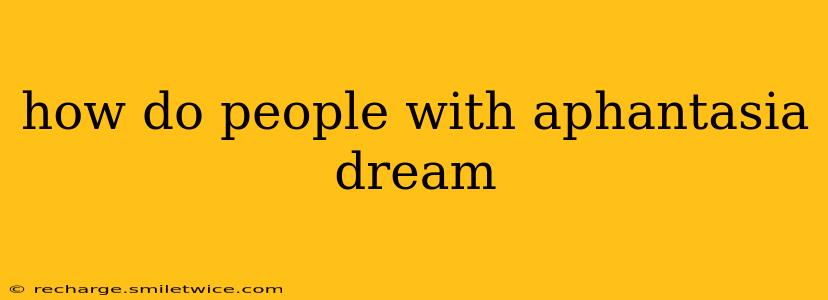How Do People With Aphantasia Dream?
Aphantasia, the inability to create mental images, is a fascinating neurological condition affecting how individuals experience visual imagery. A common question arises: how do people with aphantasia dream? Since dreaming is often associated with vivid visual experiences, understanding the dreaming experience of those with aphantasia sheds light on the complexities of both dreaming and visual perception. The short answer is that they dream, but the nature of their dreams is quite different from those who experience imagery.
Do people with aphantasia have dreams?
Yes, absolutely. Aphantasia affects the conscious creation of mental images, but it doesn't necessarily eliminate dreaming altogether. Dreams are complex neurological events involving multiple brain regions and sensory experiences beyond just visual input. While someone with aphantasia might not "see" images in their dreams in the same way a person with typical visual imagery does, they still experience dreams. These dreams are likely experienced through other sensory modalities like sound, touch, smell, taste, and emotion.
What do dreams feel like for someone with aphantasia?
This is highly individual, as the experience of dreaming is subjective even for those without aphantasia. However, individuals with aphantasia often describe their dreams as:
- Narrative-driven: The dream may unfold as a story or sequence of events, much like a radio play, focusing on the plot and emotional impact rather than visual details.
- Emotionally intense: The feelings and emotions associated with the dream are often described as strong and vivid, even without visual imagery. The emotional impact can be the primary defining characteristic of the dream.
- Sound-based: Auditory experiences, such as conversations, music, or environmental sounds, might be prominent elements.
- Abstract and conceptual: The dream's content may feel abstract or conceptual, focusing on ideas, emotions, or abstract concepts rather than concrete visual scenes.
- Feeling-based: Some describe dreams dominated by feelings and physical sensations, like the feeling of warmth, cold, or movement, without associated visuals.
How does dreaming differ for people with and without aphantasia?
The key difference lies in the sensory dominance. Individuals with typical visual imagery report predominantly visual dreams. For individuals with aphantasia, visual imagery is absent, shifting the focus to other senses – auditory, tactile, olfactory, gustatory, and emotional – in their dream experience. The narrative and emotional impact remain central, but the sensory modality shifts.
Is it possible to have aphantasia and vivid dreams?
While the absence of visual imagery defines aphantasia, the intensity of other sensory experiences during dreaming can create a similarly "vivid" experience, even without visual components. A dream dominated by sounds or intense emotions can feel just as real and memorable as a visually rich dream for someone without aphantasia.
Can aphantasia affect the recall of dreams?
Dream recall itself is a complex process that isn't directly linked to the presence or absence of visual imagery. Individuals with aphantasia might still recall their dreams, but the way they describe them reflects the sensory dominance of their dreams – often focusing on the narrative, emotions, or soundscape rather than visual details.
How is dreaming studied in individuals with aphantasia?
Research on dreaming in individuals with aphantasia is still emerging. Studies typically rely on self-reporting through questionnaires and interviews, providing valuable insights into subjective experiences. Future research may leverage brain imaging techniques to explore the neurological underpinnings of dreaming in individuals with aphantasia.
In conclusion, aphantasia profoundly influences the sensory landscape of dreams, shifting the emphasis away from visual imagery towards other sensory inputs and emotional responses. However, it doesn't eliminate the dreaming process itself, demonstrating the multifaceted nature of dreaming and the brain's capacity for creating meaningful experiences even in the absence of visual imagery.
